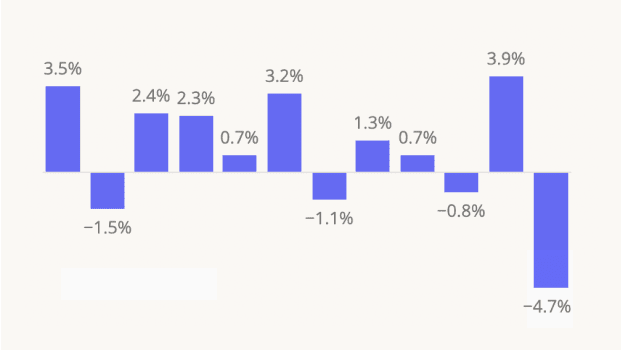As the U.S. economy moves to the midpoint of 2025, a divergent macro picture is starting to take hold. While consumers are showing renewed confidence and returning to stores (or at the very least, responding to heightened promotional activity across many retail categories), the industrial backbone of the economy – manufacturing and shipping – is tapping the brakes. This split narrative suggests that while immediate consumer sentiment has improved as tariff-related news has taken a backseat, industrial signals may be painting a more cautious picture.
Retail Visits Normalize, but are Trends Sustainable?
The retail sector has seen a welcome rebound in May and June, following a sluggish start to the year when macroeconomic uncertainty and significant tariff-related news dampened spirits and hurt foot traffic in February and March. Year-over-year visitation data for the Placer 100 index – a composite of 100 of the largest retail and restaurant chains in the U.S. – indicates that shoppers have likely grown accustomed to the economic climate and are demonstrating more consistent and normal behaviors.
With the initial shock of potential price hikes having passed, consumers appear to be moving past the cautious approach that marked the first quarter, leading to stabilized and improving year-over-year visit trends across many retail categories.
Strength Spanning Multiple Retail Categories
Admittedly, there are multiple factors driving the recent increases in year-over-year retail traffic. Consumers remain squarely focused on value, which continues to drive outperformance for value grocers, warehouse clubs, and dollar stores (which also appear to be benefiting from less competition from Temu and Shein amid new regulatory restrictions). Off-price retailers continue to be one of the strongest performing categories year-to-date, capitalizing on increased inventory opportunities stemming from recent store closures and tariff-related supply chain disruptions, allowing them to fuel their "treasure hunt" model. Finally, traditional department stores have also contributed to the rebound through strong reception to events like Nordstrom’s Half-Yearly Sale and other promotional activity.
A Cautious Industrial Sector
While retail visits have normalized in recent weeks, a different story is unfolding across U.S. factories and ports. Following a production surge in late March and April – when manufacturers ramped up activity to build inventory ahead of tariff deadlines – both manufacturing and port activity have seen a notable decline in May and into June.
Placer’s Industrial Manufacturing composite indicates that activity at manufacturing facilities – representing visits for both facility employees (estimated based on dwell time) and visitors, who often represent logistics partners – slowed in May and June.
Looking at manufacturing visit data by category, many U.S. factories took a breather in May, with our data showing a widespread slowdown in visits. The auto and auto parts industry has been hit particularly hard, feeling the direct impact of international tariffs. But this isn't just a car story – most other manufacturing sectors also pumped the brakes, signaling that many companies are cautiously getting ready for what could be an unpredictable second half of the year.
Port Data Also Raises Concerns
Slowing new orders and decreasing container volumes at major ports suggest that businesses, having already front-loaded their inventory, are now taking a more cautious look toward the second half of 2025. Many appear hesitant to over-commit amidst an unpredictable trade policy landscape.
Our visitation data for some of the busiest ports in the U.S. generally shows a strong correlation with the Bureau of Transportation's container import and export statistics. While our data indicated increased activity at several Eastern ports ahead of initial tariff implementation dates in early April, we have since observed visitation trends declining through much of April and May. The one notable exception is the Port of Houston – where gasoline imports are often received – which saw a spike in activity in May that has continued through June.
Shoppers Return, Factories Slow
The two-track U.S. economy at the mid-point of 2025 highlights a clear divergence between consumer behavior and industrial strategy. While shoppers have returned to stores, driven by a hunt for value and successful promotions, the industrial sector is sending more cautious signals. The slowdown in activity at manufacturing facilities and ports suggests that businesses, having already front-loaded inventory ahead of tariffs, are now bracing for potential volatility. This sets up a classic economic tug-of-war for the second half of the year, leaving a critical question: Will resilient consumer spending eventually pull the industrial sector back into a growth cycle, or will the manufacturing slowdown ultimately impact supply chains, shelf availability, and the recent retail rebound?
For more data-driven retail insights, visit placer.ai/anchor.




.svg)





.png)
.png)

.png)
.png)






.avif)


